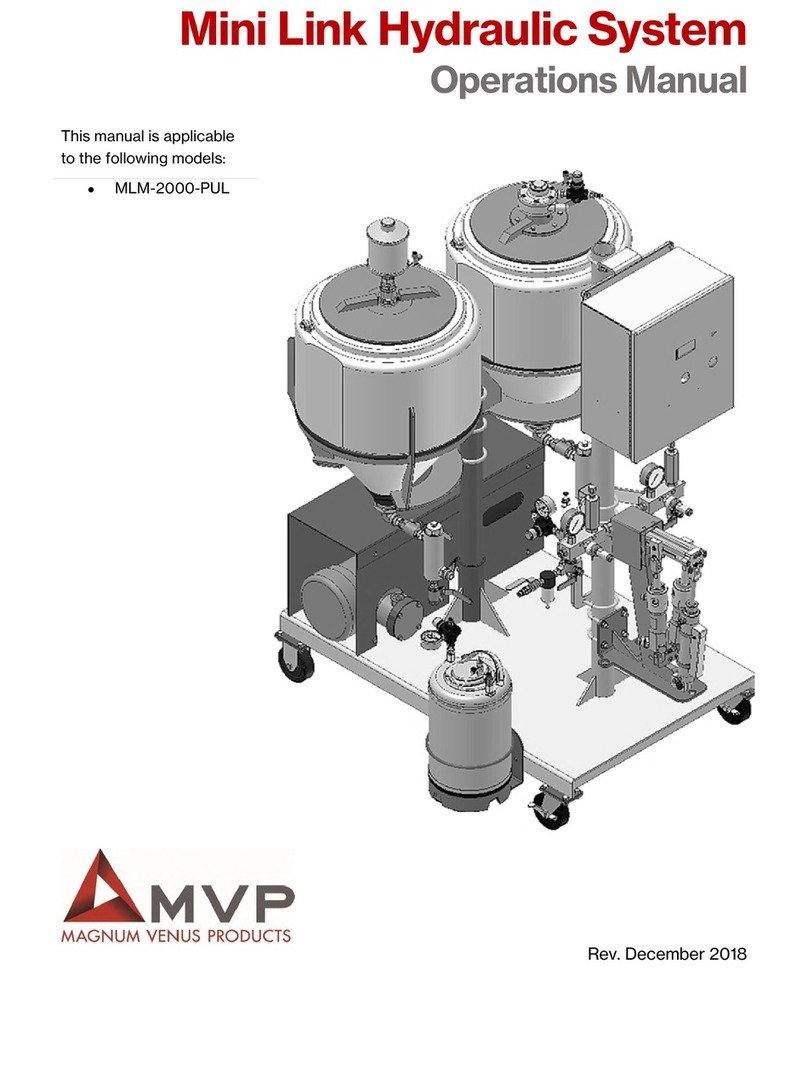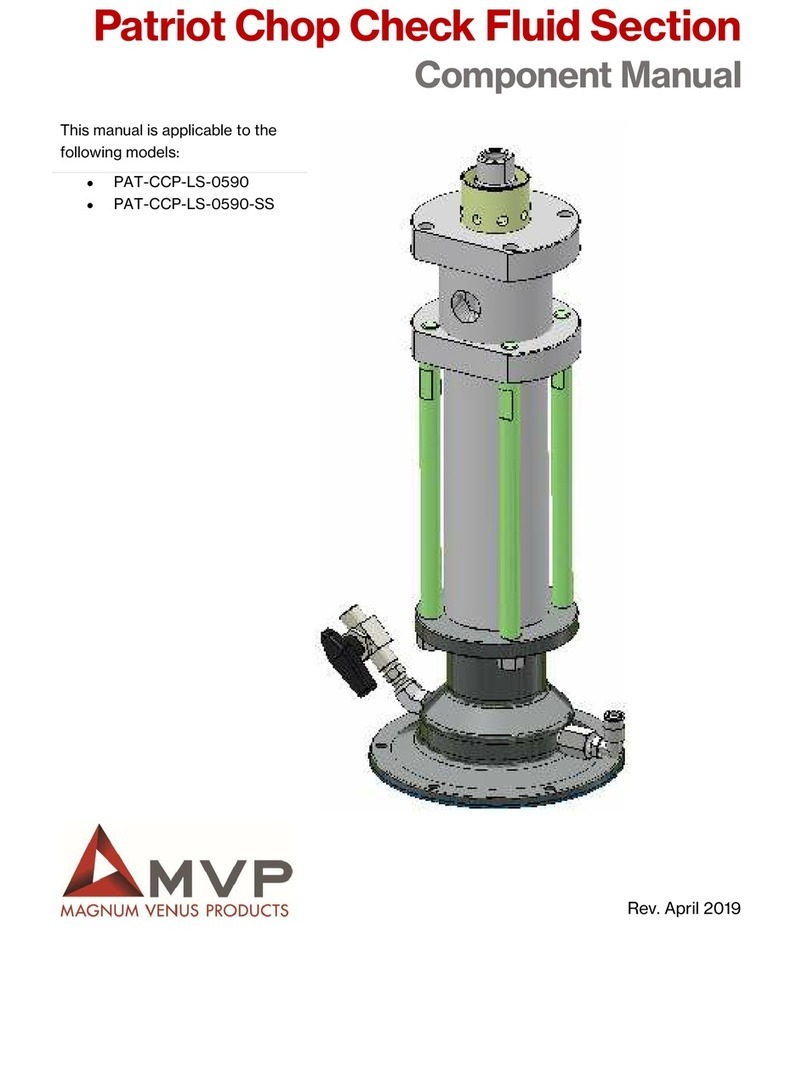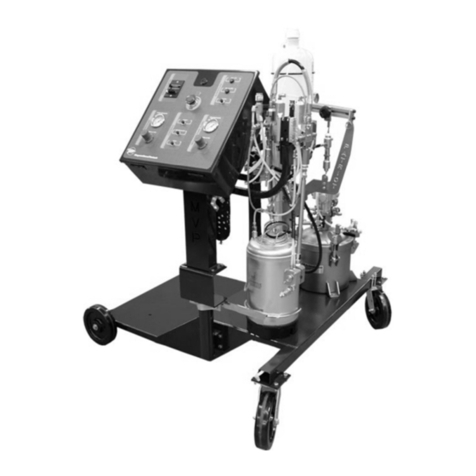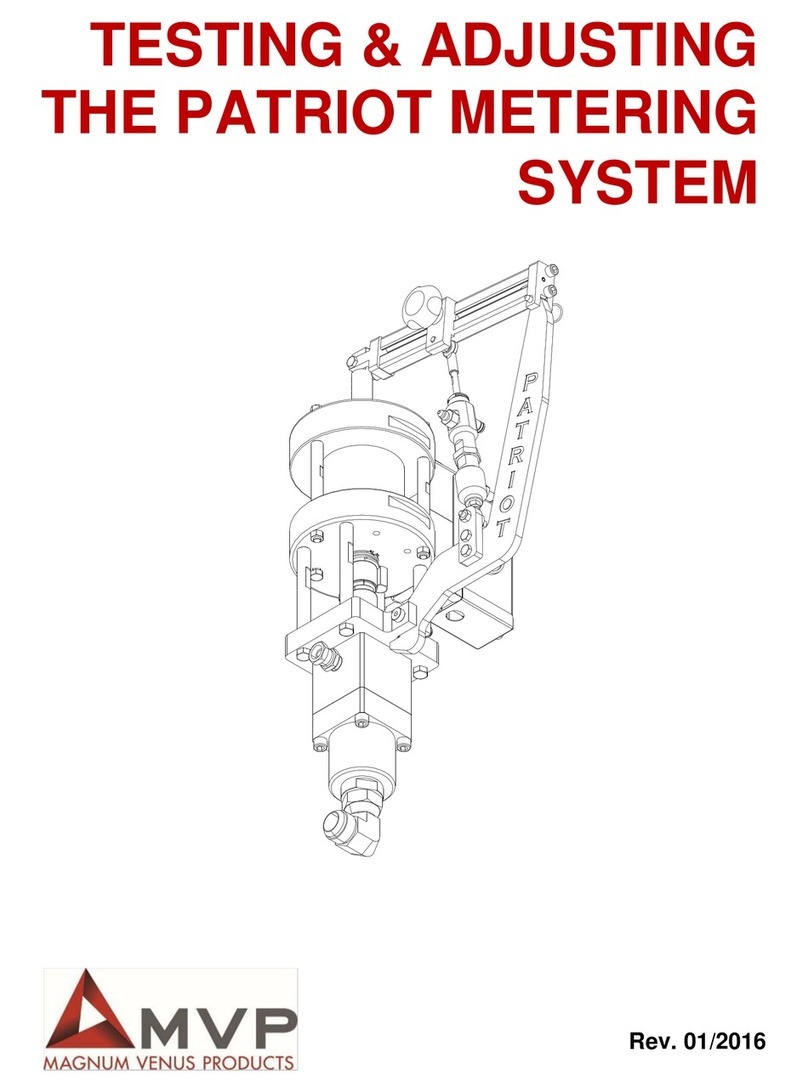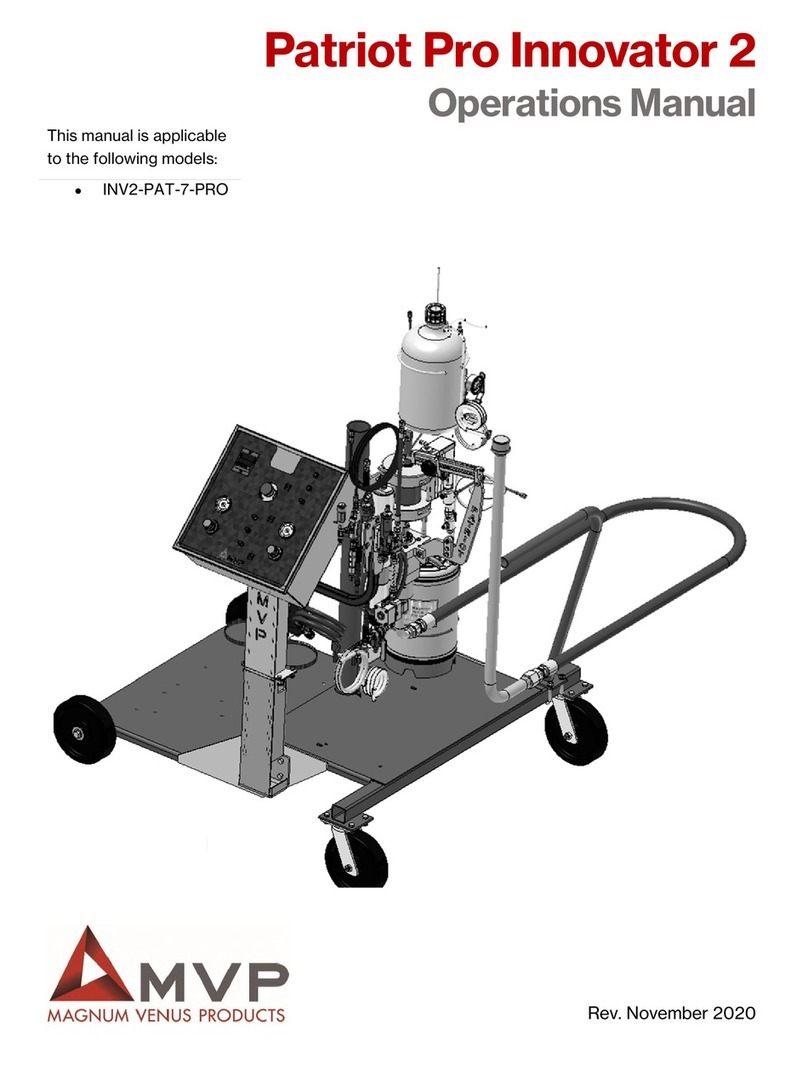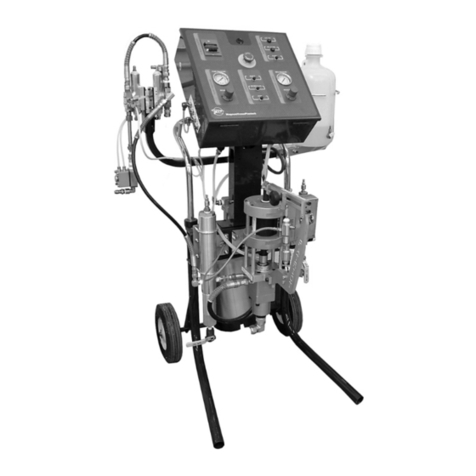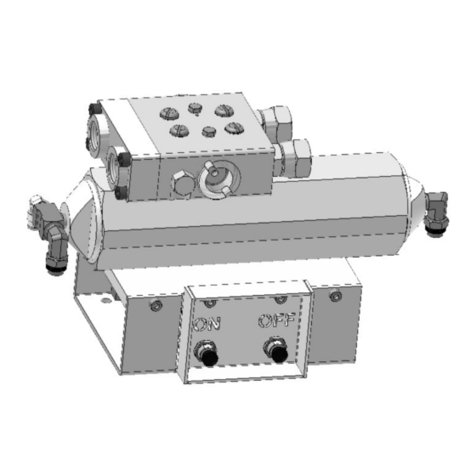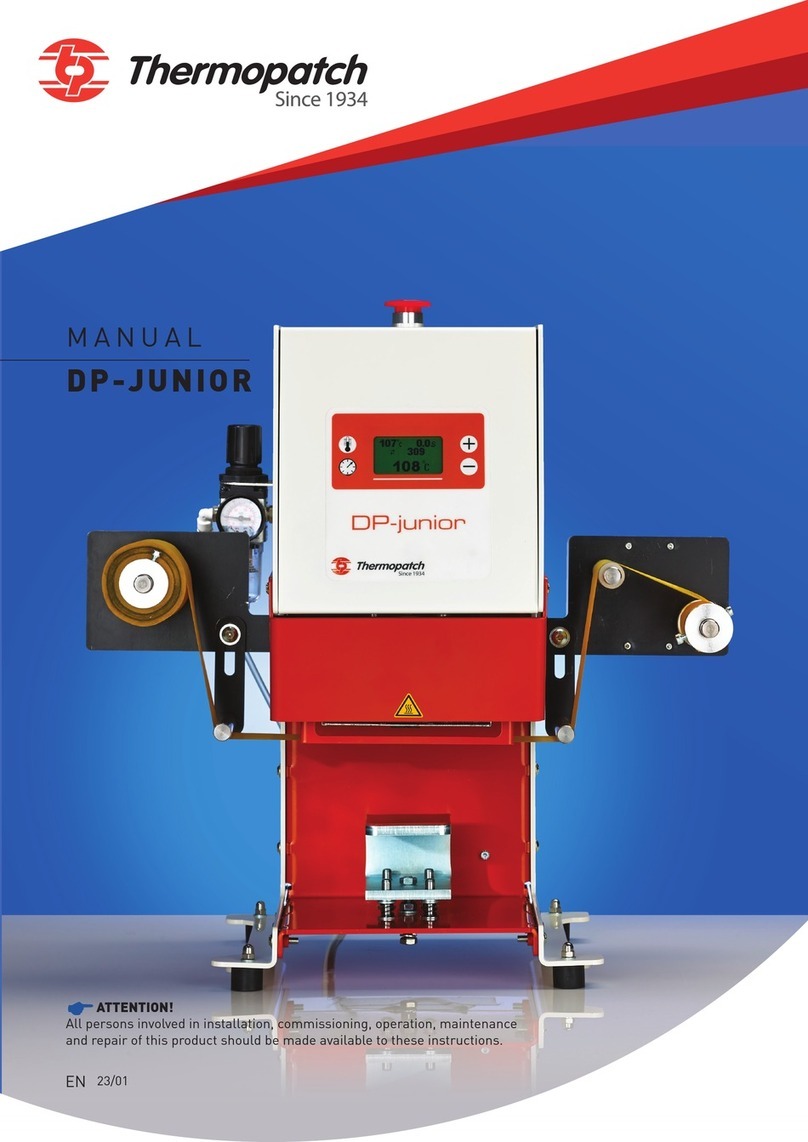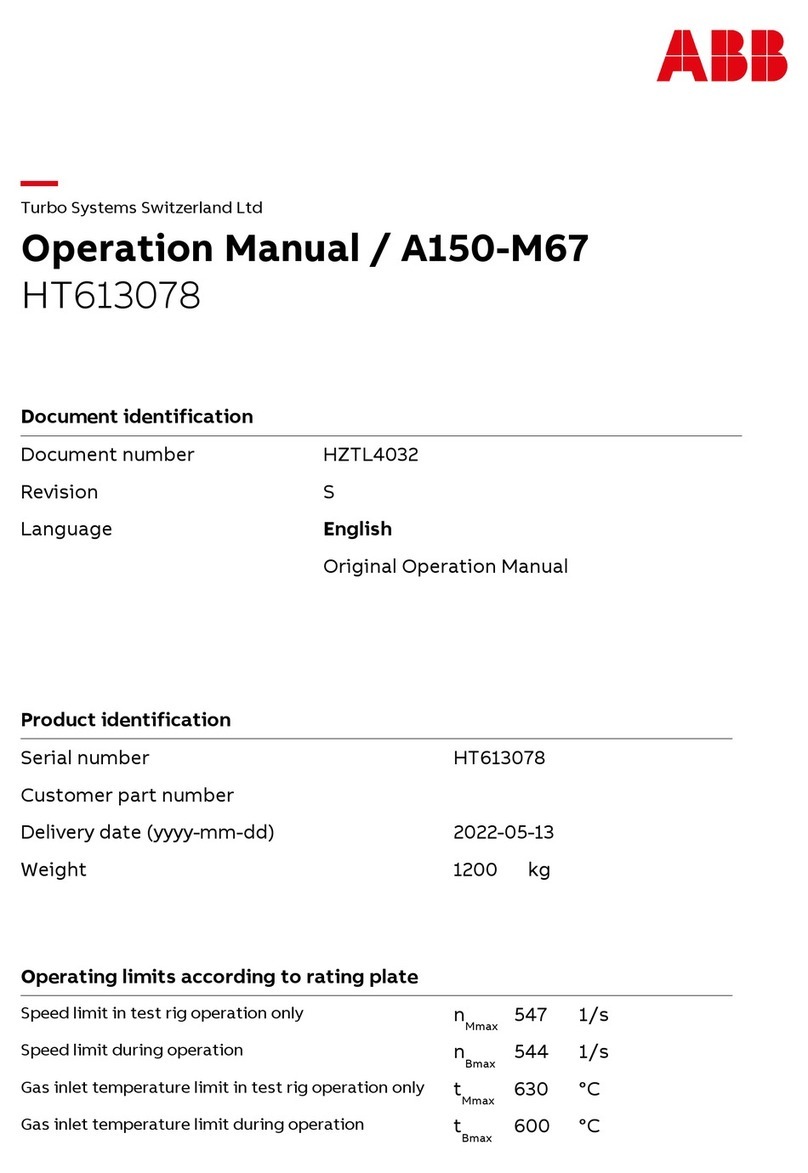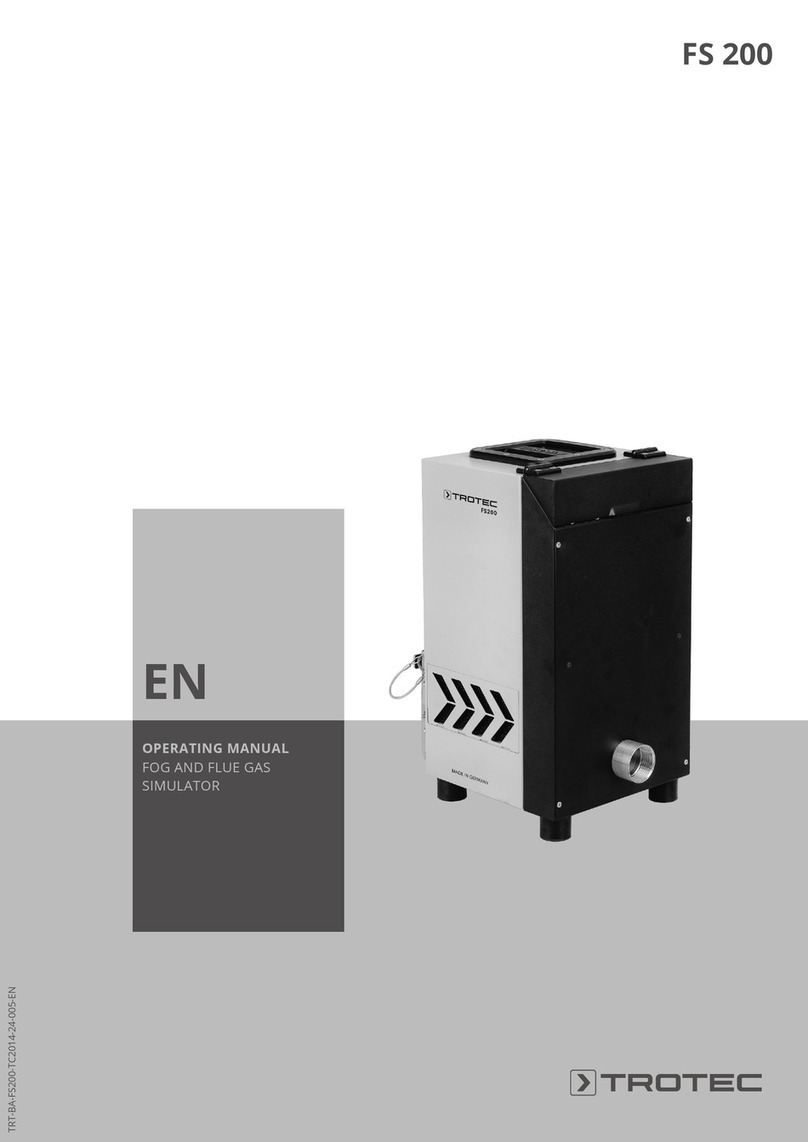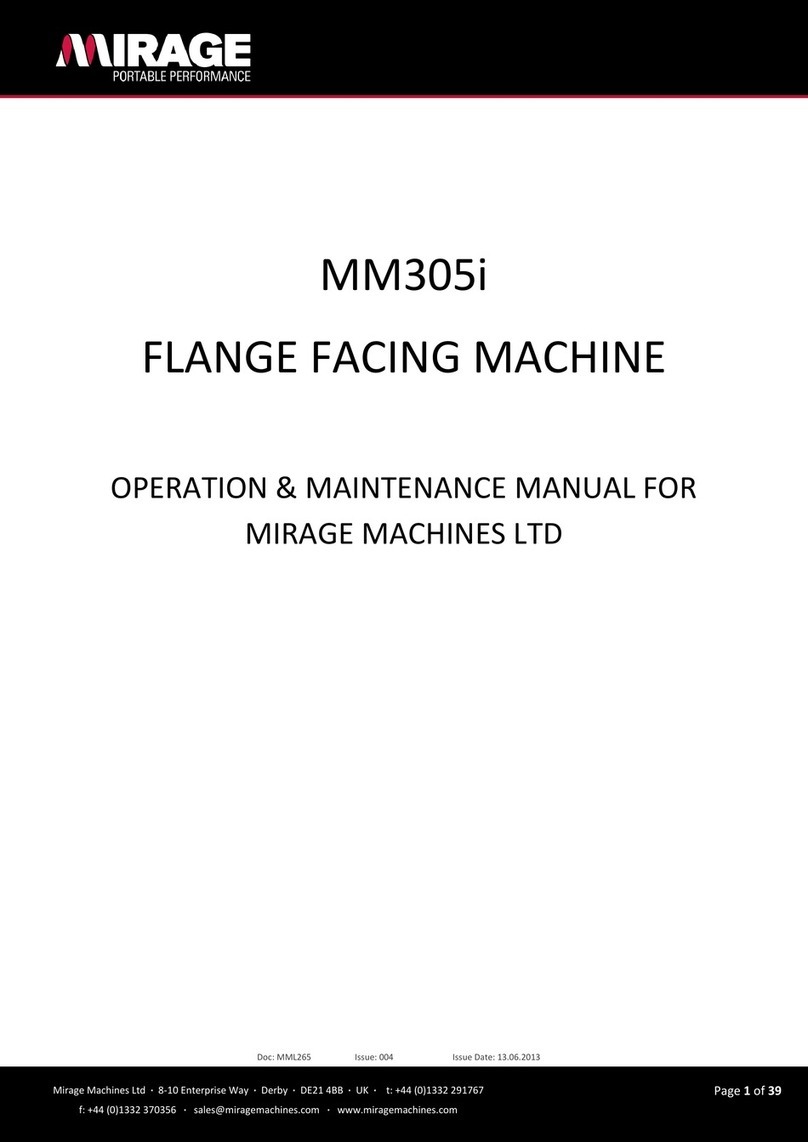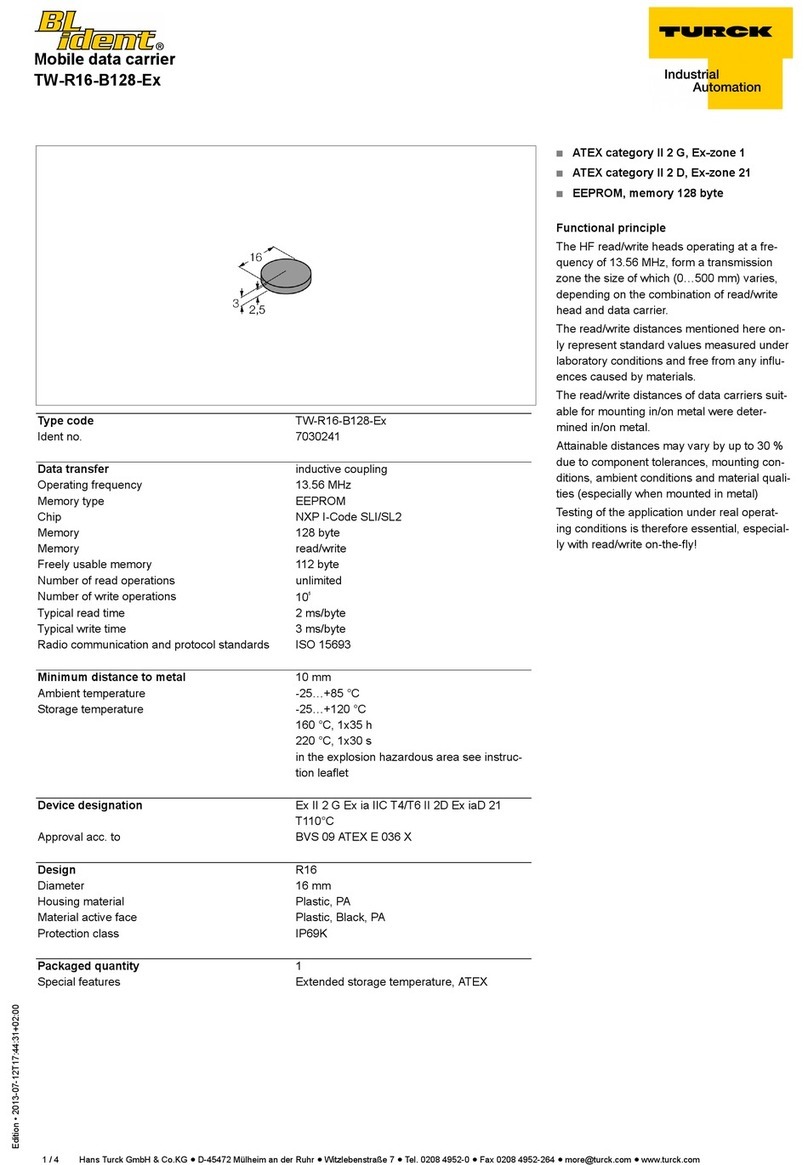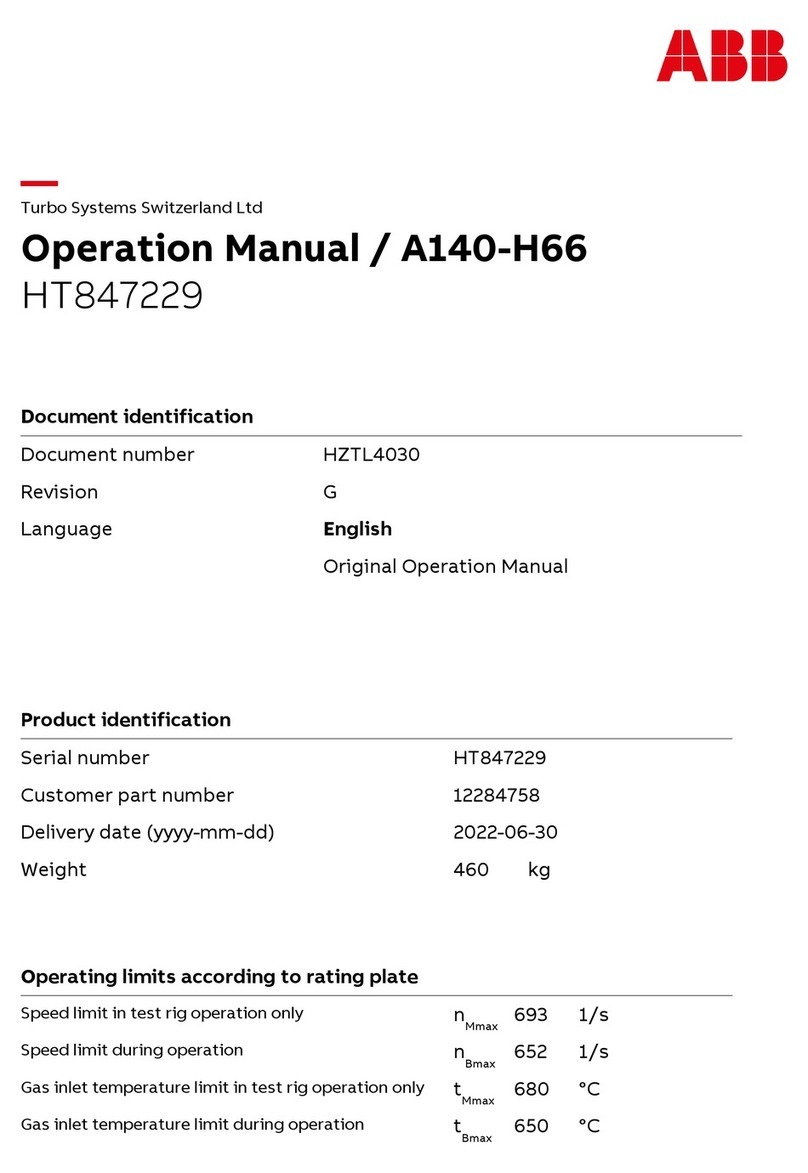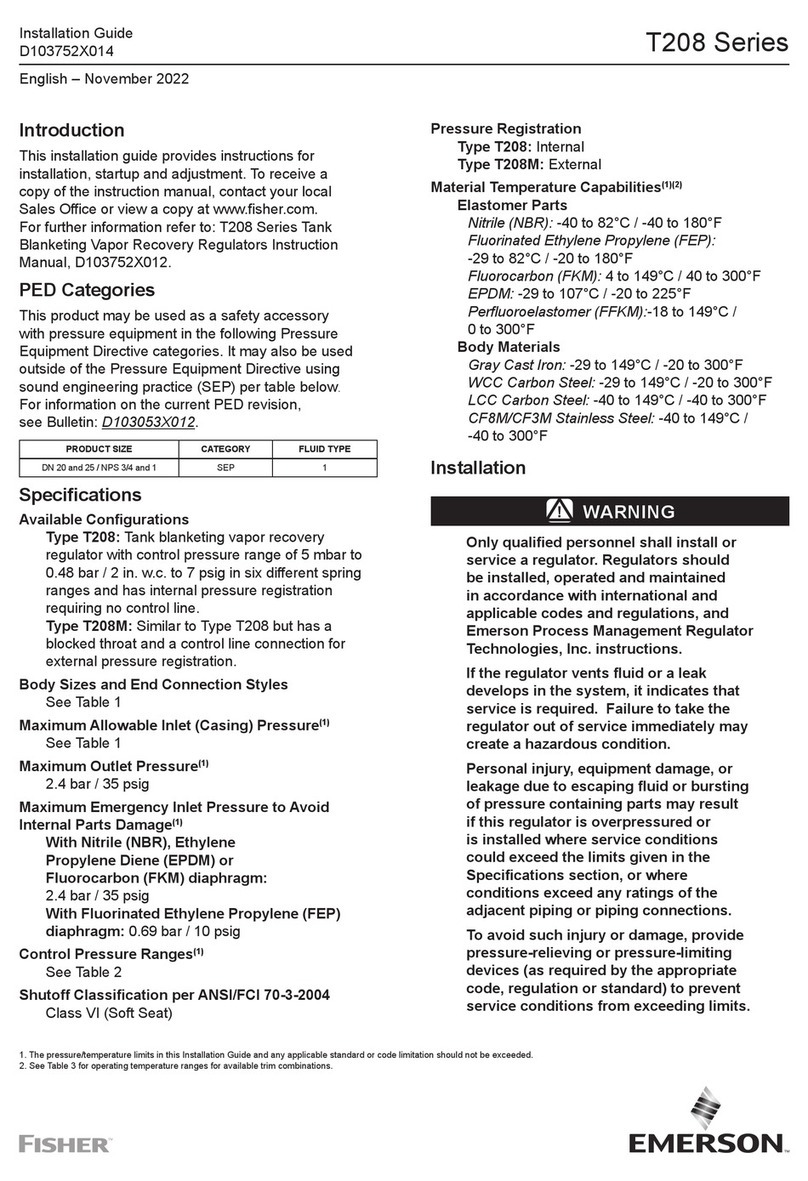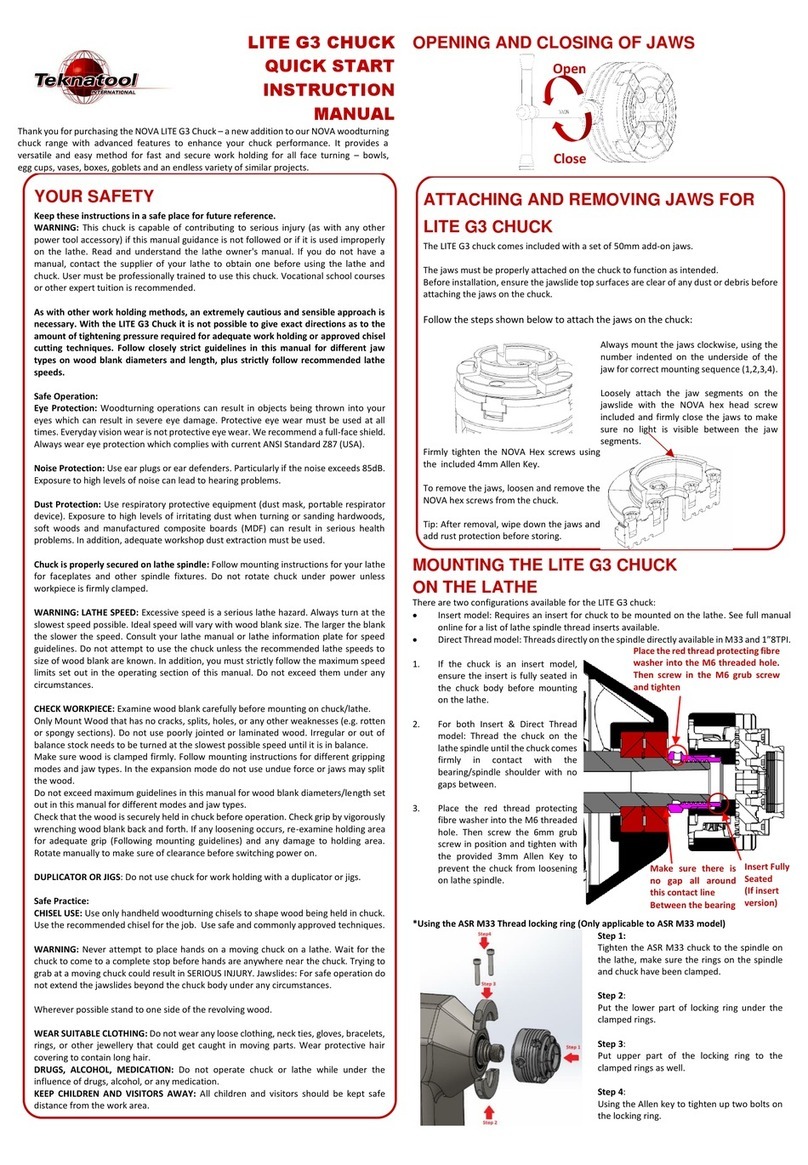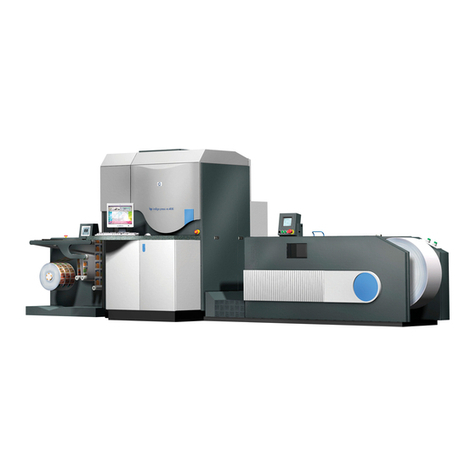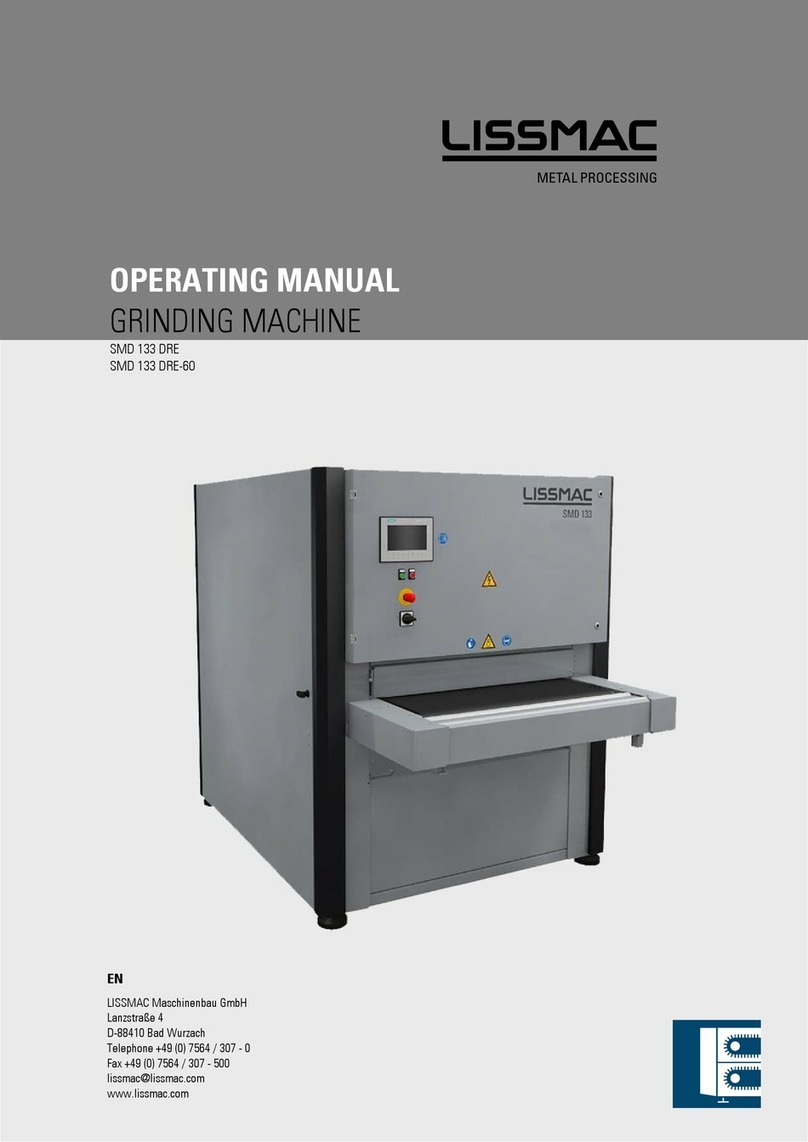MVP HVLS-1000 User manual

HV Series Fluid Section
Operations Manual
This manual is applicable to the
following models:
HVLS-1000
HVLS-1000-DHV
HVLS-1000-HD
HVLS-1000-SS
MCPA-HVLS
UPLS-1000
HVLS-2000-2
HVLS-2000-4
HVLS-2000-1-DHV
Rev.
March 2019

HV Series Fluid Section Operations Manual
Page | 2
CORPORATE HEADQUARTERS
2030 Falling Waters Rd, Suite 350, Knoxville, TN 37922 · USA · Tel: (865) 686-5670
DISTRIBUTION AND PURCHASING
642 Barbrow Ln, Knoxville, TN 37932 · USA · Tel: (865) 684-4416
TECHNOLOGY CENTER AND MANUFACTURING
1862 Ives Ave, Kent, WA 98032 · USA · Tel (253) 854-2660 · Fax (253) 854-1666
E-mail: [email protected]om
For a list of international distributors, visit our website at :
www.mvpind.com/mvp-international
Use of this product confirms that Magnum Venus Products, Inc.’s standard terms and
conditions of sale apply.

HV Series Fluid Section Operations Manual
Page | 3
Table of Contents
Section Page
Table of Contents 3
Safety & Warning Information 4
Introduction 15
Installing Fluid Section 17
Maintaining Fluid Section 18
Disassembling Fluid Section 19
Reassembling Fluid Section 21
Servicing Accumulator & Filter 23
Troubleshooting 24
Specifications 25
Parts Drawings 27

HV Series Fluid Section Operations Manual
Page | 4
Safety & Warning Information
Warnings
Due to the vast number of chemicals that could be used and their varying chemical reactions, the
buyer and user of this equipment should determine all factors relating to the fluids used, including
any of the potential hazards involved. Particular inquiry and investigation should be made into
potential dangers relating to toxic fumes, fires, explosions, reaction times, and exposure of
human beings to the individual components or their resultant mixtures. MVP assumes no
responsibility for loss, damage, expense or claims for bodily injury or property damage, direct or
consequential, arising from the use of such chemical components.
The end user is responsible for ensuring that the end product or system complies with all the
relevant laws in the country where it is to be used and that all documentation is adhered to.
Recommended Occupational Safety & Health Act (OSHA) Documentation:
1910.94 Pertaining to ventilation
1910.106 Pertaining to flammable liquids
1910.107
Pertaining to spray finishing operations, particularly paragraph (m),
Organic Peroxides and Dual Component Coatings
For Additional information, contact the Occupational Safety and Health Administration (OSHA)
at https://www.osha.gov/about.html.
Recommended National Fire Protection Association (NFPA) Documentation:
NFPA No.33 Chapter 14 Organic Peroxides and Dual Component Materials
NFPA No. 63 Dust Explosion Prevention
NFPA No. 70 National Electrical Code
NFPA No. 77 Static Electricity
NFPA No. 91 Blower and Exhaust System
NFPA No. 654 Plastics Industry Dust Hazards
Fire Extinguisher – code ABC, rating number 4a60bc using Extinguishing Media –Foam,
Carbon Dioxide, Dry Chemical, Water Fog, is recommended for this product and applications.
The following general warnings and guidelines are for the setup, use, grounding, maintenance,
and repair of equipment. Additional product-specific warnings may be found throughout this
manual as applicable. Please contact your nearest MVP Technical Service Representative if
additional information is needed.

HV Series Fluid Section Operations Manual
Page | 5
Safety Precautions
Avoid skin contact and inhalation of all chemicals.
Review Material Safety Data Sheet (MSDS) to promote the safe handling of chemicals in
use.
Restrict the use of all chemicals to designated areas with good ventilation.
Chemicals are flammable and reactive.
Noxious fumes released when combusted.
Operate equipment in a ventilated environment only.
Uncured liquid resins are highly flammable unless specifically labeled otherwise.
Cured laminate, accumulations of overspray, and laminate sandings are highly combustible.
Do not operate or move electrical equipment when flammable fumes are present.
Ground all equipment.
If a spark is seen or felt, immediately halt operation. Do not operate the equipment until the
issue has been identified and repaired.
Contaminated catalyst may cause fire or explosion.
Containers may explode if exposed to fire / heat.
Use and store chemicals away from heat, flames, and sparks.
Do not smoke in work areas or near stored chemicals.
Do not mix Methyl Ethyl Ketone Peroxide (MEKP) with materials other than polyethylene.
Do not dilute MEKP.
Keep food and drink away from work area.

HV Series Fluid Section Operations Manual
Page | 6
Physical Hazards
Never look directly into the spray gun fluid tip. Serious injury or death can result.
Never aim the spray gun at or near another person. Serious injury or death can result.
Chemical compounds can be severely irritating to the eyes and skin.
Inhalation, ingestion, or injection may damage internal organs and lead to pulmonary disorders, cancers,
lymphomas, and other diseases or health conditions.
Other potential health effects include: irritation of the eyes and upper respiratory tract, headache, light-
headedness, dizziness, confusion, drowsiness, nausea, vomiting, and occasionally abdominal pain.
Eye contact: Immediately flush with water for at least 15 minutes and seek immediate medical attention.
Skin Contact: Immediately wash with soap and water and seek immediate medical attention.
Inhalation: Move the person to fresh air and seek immediate medical attention.
Do not remove shields, covers, or safety features on equipment that is in use.
Never place fingers, hands, or any body part near or directly in front of the spray gun fluid tip. The force
of the liquid as it exits the spray tip can shoot liquid through the skin.
Keep hands and body parts away from any moving equipment or components.
Do not stand under plunger
An improperly loaded drum may lead to an imbalance, causing a unit to tip over
Personal Protective Equipment (PPE)
MVP recommends the use of personal safety equipment with all products in our catalog.
Wear safety goggles, hearing protection, a respirator, and chemical resistant gloves.
Wear long sleeve shirts or jackets and pants to minimize skin exposure.
PPE should be worn by operators and service technicians to reduce the risk of injury.
For Additional information, contact the Occupational Safety and Health Administration
(OSHA). https://www.osha.gov/about.html

HV Series Fluid Section Operations Manual
Page | 7
Symbol Definitions
Indicates the risk of
contact with chemicals
that are hazardous, which
may lead to injury or
death.
Indicates the risk of
contact with voltage /
amperage that may lead
to serious injury or death
Indicates that the
materials being used are
susceptible to combustion
Indicates the risk of
contact with moving
components that may
lead to serious injury or
death.
Indicates that the system
or component should be
grounded before
proceeding with use or
repair.
Indicates the use of lit
cigarettes or cigars is
prohibited, because the
materials being used are
susceptible to
combustion.
Indicates that the
materials and/or the
process being performed
can lead to ignition and
explosion.
A recommendation for
the use of Personal
Protective Equipment
(PPE) before using or
repairing the product.

HV Series Fluid Section Operations Manual
Page | 8
Polymer Matrix Materials: Advanced Composites
Potential health hazards associated with the use of advanced composites can be controlled through
the implementation of an effective industrial hygiene and safety program.
https://www.osha.gov/dts/osta/otm/otm_iii/otm_iii_1.html#t iii:1_1
Resins
Composite Component Organ System Target
(Possible Target)
Known (Possible) Health Effect
Epoxy resins Skin, lungs, eyes Contact and allergic dermatitis,
conjunctivitis
Polyurethane resins Lungs, skin, eyes Respiratory sensitization, contact
dermatitis, conjunctivitis
Phenol formaldehyde Skin, lungs, eyes As above (potential carcinogen)
Bismaleimides (BMI) Skin, lungs, eyes As above (potential carcinogen)
Polyamides Skin, lungs, eyes As above (potential carcinogen)
Reinforcing materials
Composite Component Organ System Target
(Possible Target)
Known (Possible) Health Effect
Aramid fibers Skin (lungs) Skin and respiratory irritation, contact
dermatitis (chronic interstitial lung disease)
Carbon/graphite fibers Skin (lungs) As noted for aramid fibers
Glass fibers (continuous
filament) Skin (lungs) As noted for aramid fibers
Hardeners and curing agents
Composite Component Organ System Target
(Possible Target)
Known (Possible) Health Effect
Diaminodiphenylsulfone N/A No known effects with workplace
exposure
Methylenedianiline Liver, skin Hepatotoxicity, suspect human carcinogen
Other aromatic amines
Composite Component Organ System Target
(Possible Target)
Known (Possible) Health Effect
Meta-phenylenediamine (MPDA) Liver, skin (kidney,
bladder)
Hepatitis, contact dermatitis (kidney and
bladder cancer)
Aliphatic andcyclo-aliphatic
amines
Eyes, skin Severe irritation, contact dermatitis
Polyaminoamide Eyes, skin Irritation (sensitization)
Anhydride Eyes, lungs, skin Severe eye and skin irritation, respiratory
sensitization, contact dermatitis

HV Series Fluid Section Operations Manual
Page | 9
Catalyst - Methyl Ethyl Ketone Peroxide (MEKP)
MEKP is among the more hazardous materials found in commercial channels. The safe handling
of the “unstable (reactive)” chemicals presents a definite challenge to the plastics industry. The
highly reactive property which makes MEKP valuable to the plastics industry in producing the
curing reaction of polyester resins also produces the hazards which require great care and caution
in its storage, transportation, handling, processing and disposal. MEKP is a single chemical.
Various polymeric forms may exist which are more or less hazardous with respect to each other.
These differences may arise not only from different molecular structures (all are, nevertheless,
called “MEKP”) and from possible trace impurities left from the manufacture of the chemicals, but
may also arise by contamination of MEKP with other materials in its storage or use. Even a small
amount of contamination with acetone, for instance, may produce an extremely shock-sensitive
and explosive compound.
WARNING
Contamination with promoters, materials containing promoters (such as
laminate sandings), or with any readily oxidizing material (such as brass or
iron) will cause exothermic redox reactions which can be explosive in
nature. Heat applied to MEKP or heat buildup from contamination reactions
can cause the material to reach its Self-Accelerating Decomposition
Temperature (SADT).
Researchers have reported measuring pressure rates-of-rise well over 100,000 psi per second when
certain MEKP’s reach their SADT. For comparison, the highest-pressure rate-of-rise listed in
NFPA Bulletin NO.68, “Explosion Venting”, is 12,000 psi per second for an explosion of 12%
acetylene and air. The maximum value listed for a hydrogen explosion is 10,000 psi per second.
Some forms of MEKP, if allowed to reach their SADT, will burst even an open topped container.
This suggests that it is not possible to design a relief valve to vent this order of magnitude of
pressure rate-of-rise. The user should be aware that any closed container, be it a pressure vessel,
surge chamber, or pressure accumulator, could explode under certain conditions. There is no
engineering substitute for care by the user in handling organic peroxide catalysts. If, at any time,
the pressure relieve valve on top of the catalyst tank should vent, the area should be evacuated at
once and the fire department called. The venting could be the first indication of a heat, and
therefore, pressure build-up that could eventually lead to an explosion. Moreover, if a catalyst
tank is sufficiently full when the pressure relief valve vents, some catalyst may spray out, which
could cause eye injury. For this reason, and many others, anyone whose job puts them in an area
where this vented spray might go, should always wear full eye protection even when laminating
operations are not taking place.
Safety in handling MEKP depends to a great extent on employee education, proper safety
instructions, and safe use of the chemicals and equipment. Workers should be thoroughly
informed of the hazards that may result from improper handling of MEKP, especially regarding
contamination, heat, friction and impact. They should be thoroughly instructed regarding the
proper action to be taken in the storage, use, and disposal of MEKP and other hazardous
materials used in the laminating operation. In addition, users should make every effort to:
Store MEKP in a cool, dry place in original containers away from direct sunlight and away
from other chemicals.
Keep MEKP away from heat, sparks, and open flames.
Prevent contamination or MEKP with other materials, including polyester over spray and
sandings, polymerization accelerators and promoters, brass, aluminum, and non-stainless
steels.

HV Series Fluid Section Operations Manual
Page | 10
Never add MEKP to anything that is hot, since explosive decomposition may result.
Avoid contact with skin, eyes, and clothing. Protective equipment should be worn at all
times. During clean-up of spilled MEKP, personal safety equipment, gloves, and eye
protection must be worn. Firefighting equipment should be at hand and ready.
Avoid spillage, which can heat up to the point of self-ignition.
Repair any leaks discovered in the catalyst system immediately, and clean-up the leaked
catalyst at once in accordance with the catalyst manufacturer’s instructions.
Use only original equipment or equivalent parts from Magnum Venus Products in the catalyst
system (i.e.: hoses, fitting, etc.) because a dangerous chemical reaction may result between
substituted parts and MEKP.
Catalyst accumulated from the purging of hoses or the measurement of fluid output
deliveries should never be returned to the supply tank, such catalyst should be diluted with
copious quantities of clean water and disposed of in accordance with the catalyst
manufacturer’s instructions.
The extent to which the user is successful in accomplishing these ends and any additional
recommendations by the catalyst manufacturer determines largely the safety that will be present
in his operation.
Clean-Up Solvents and Resin Diluents
WARNING
A hazardous situation may be present in your pressurized fluid system! Hydro
carbon solvents can cause an explosion when used with aluminum or
galvanized components in a closed (pressurized) fluid system (pump,
heaters, filters, valves, spray guns, tanks, etc.). An explosion could cause
serious injury, death, and/or substantial property damage. Cleaning agents,
coatings, paints, etc. may contain Halogenated Hyrdrocarbon solvents. Some
Magnum Venus Products spray equipment includes aluminum or galvanized
components and will be affected by Halogenated Hydrocarbon solvents.
There are three key elements to the Halogenated Hyrdocarbon (HHC) solvent hazard.
1. The presence of HHC
solvents.
1,1,1 – Trichloroethane and Methylene Chloride are the most common of
these solvents. However, other HHC solvents are suspect if used; either
as part of paint or adhesives formulation, or for clean-up flushing.
2. Aluminum or
Galvanized Parts.
Most handling equipment contains these elements. In contact with
these metals, HHC solvents could generate a corrosive reaction of a
catalytic nature.
3. Equipment capable of
withstanding pressure.
When HHC solvent contact aluminum or galvanized parts inside a
closed container such as a pump, spray gun, or fluid handling system,
the chemical reaction can, over time, result in a build-up of heat and
pressure, which can reach explosive proportions. When all three
elements are present, the result can be an extremely violent explosion.
The reaction can be sustained with very little aluminum or galvanized
metal; any amount of aluminum is too much.

HV Series Fluid Section Operations Manual
Page | 11
The reaction is unpredictable. Prior use of an HHC solvent without incident (corrosion or
explosion) does NOT mean that such use is safe. These solvents can be dangerous alone (as a
clean-up or flushing agent) or when used as a component or a coating material. There is no
known inhibitor that is effective under all circumstances. Mixing HHC solvents with other
materials or solvents such as MEKP, alcohol, or toluene may render the inhibitors ineffective.
The use of reclaimed solvents is particularly hazardous. Reclaimers may not add any inhibitors.
The possible presence of water in reclaimed solvents could also feed the reaction.
Anodized or other oxide coatings cannot be relied upon to prevent the explosive reaction. Such
coatings can be worn, cracked, scratched, or too thin to prevent contact. There is no known way
to make oxide coatings or to employ aluminum alloys to safely prevent the chemical reaction
under all circumstances.
Several solvent suppliers have recently begun promoting HHC solvents for use in coating
systems. The increasing use of HHC solvents is increasing the risk. Because of their exemption
from many state implementation plans as Volatile Organic Compounds (VOCs), their low
flammability hazard, and their not being classified as toxic or carcinogenic substances, HHC
solvents are very desirable in many respects.
WARNING
Do not use Halogenated Hydrocarbon (HHC) solvents in pressurized fluid
systems having aluminum or galvanized wetted parts.
Magnum Venus Products is aware of NO stabilizers available to prevent HHC
solvents from reaction under all conditions with aluminum components in
closed fluid systems. HHC solvents are dangerous when used with aluminum
components in a closed fluid system.
Consult your material supplier to determine whether your solvent or coating contains
Halogenated Hydrocarbon solvents.
Magnum Venus Products recommends that you contact your solvent supplier regarding the best
non-flammable clean-up solvent with the heat toxicity for your application.
If, however, you find it necessary to use flammable solvents, they must be kept in approved,
electrically grounded containers.
Bulk solvent should be stored in a well-ventilated, separate building, 50 feet away from your main
plant.
You should only allow enough solvent for one day’s use in your laminating area.
NO SMOKING signs must be posted and observed in all areas of storage or where solvents and
other flammable materials are used.
Adequate ventilation (as covered in OSHA Section 1910.94 and NFPA No.91) is important
wherever solvents are stored or used, to minimize, confine and exhaust the solvent vapors.
Solvents should be handled in accordance with OSHA Section 1910.106 and 1910.107.

HV Series Fluid Section Operations Manual
Page | 12
Catalyst Diluents
Magnum Venus Products spray-up and gel-coat systems currently produced are designed so that
catalyst diluents are not required. Magnum Venus Products therefore recommends that diluents
not be used to avoid possible contamination which could lead to an explosion due to the handling
and mixing of MEKP and diluents. In addition, it eliminates any problems from the diluent being
contaminated through rust particles in drums, poor quality control on the part of the diluents
suppliers, or any other reason. If diluents are absolutely required, contact your catalyst supplier
and follow his instructions explicitly. Preferably the supplier should premix the catalyst to prevent
possible “on the job” contamination while mixing.
WARNING
If diluents are not used, remember that catalyst spillage and gun, hose,
and packing leaks are potentially more hazardous since each drop
contains a higher concentration of catalyst and will therefore react more
quickly with overspray and the leak.
Cured Laminate, Overspray and Laminate Sandings Accumulation
Remove all accumulations of overspray, Fiberglass Reinforced Plastic (FRP) sandings, etc. from
the building as they occur. If this waste is allowed to build up, spillage of catalyst is more likely to
start a fire; in addition, the fire would burn hotter and longer.
Floor coverings, if used, should be non-combustible.
Spilled or leaked catalyst may cause a fire if it comes in contact with an FRP product, over-
sprayed chop or resin, FRP sandings or any other material with MEKP.
To prevent spillage and leakage, you should:
1.
Maintain your Magnum Venus
Products System.
Check the gun several times daily for catalyst and
resin packing or valve leaks. REPAIR ALL LEAKS
IMMEDIATELY.
2.
Never leave the gun hanging over
or lying inside the mold.
A catalyst leak in this situation would certainly
damage the part, possibly the mold, and may cause
a fire.
3.
Inspect resin and catalyst hoses
daily for wear or stress at the entry
and exits of the boom sections and
at the hose and fittings.
Replace if wear or weakness is evident or
suspected.
4.
Arrange the hoses and fiberglass
roving guides so that the fiberglass
strands DO NOT rub against any of
the hoses at any point.
If allowed to rub, the hose will be cut through,
causing a hazardous leakage of material which
could increase the danger of fire. Also, the material
may spew onto personnel in the area.

HV Series Fluid Section Operations Manual
Page | 13
Toxicity of Chemicals
Magnum Venus Products recommends that you consult OSHA Sections 1910.94, 1910.106,
1910.107 and NFPA No.33, Chapter 14, and NFPA No.91.
Contact your chemical supplier(s) and determine the toxicity of the various chemicals used as
well as the best methods to prevent injury, irritation and danger to personnel.
Also determine the best methods of first aid treatment for each chemical used in your plant.
Equipment Safety
Magnum Venus Products suggest that personal safety equipment such as EYE GOGGLES,
GLOVES, EAR PROTECTION, and RESPIRATORS be worn when servicing or operating this
equipment. Ear protection should be worn when operating a fiberglass chopper to protect against
hearing loss since noise levels can be as high as 116 dB (decibels). This equipment should only be
operated or serviced by technically trained personnel!
CAUTION
Never place fingers, hands, or any body part near or directly in front of the
spray gun fluid tip. The force of the liquid as it exits the spray tip can cause
serious injury by shooting liquid through the skin. NEVER LOOK DIRECTLY
INTO THE GUN SPRAY TIP OR POINT THE GUN AT OR NEAR ANOTHER
PERSON OR AN ANIMAL.
DANGER
Contaminated catalyst may cause fire or explosion. Before working on the
catalyst pump or catalyst accumulator, wash hands and tools thoroughly.
Be sure work area is free from dirt, grease, or resin. Clean catalyst system
components with clean water daily.
DANGER
Eye, skin, and respiration hazard. The catalyst MEKP may cause blindness,
skin irritation, or breathing difficulty. Keep hands away from face. Keep
food and drink away from work area.
Treatment of Chemical Injuries
CAUTION
Refer to your catalyst manufacturer’s safety information regarding the safe
handling and storage of catalyst. Wear appropriate safety equipment as
recommended.
Great care should be used in handling the chemicals (resins, catalyst and solvents) used in polyester
systems. Such chemicals should be treated as if they hurt your skin and eyes and as if they are
poison to your body. For this reason, Magnum Venus Products recommends the use of protective
clothing and eye wear in using polyester systems. However, users should be prepared in the event of
such an injury.

HV Series Fluid Section Operations Manual
Page | 14
Precautions include:
1. Know precisely what chemicals you are using and obtain information from your chemical
supplier on what to do in the event the chemical gets onto your skin or into the eyes, or if
swallowed.
2. Keep this information together and easily available so that it may be used by those
administering first aid or treating the injured person.
3. Be sure the information from your chemical supplier includes instructions on how to treat
any toxic effects the chemicals have.
WARNING
Contact your doctor immediately in the event of an injury. If the product’s
MSDS includes first aid instructions, administer first aid immediately after
contacting a doctor.
Fast treatment of the outer skin and eyes that contact chemicals generally includes immediate
and thorough washing of the exposed skin and immediate and continuous flushing of the eyes
with lots of clean water for at least 15 minutes or more. These general instructions of first aid
treatment may be incorrect for some chemicals; you must know the chemicals and treatment
before an accident occurs. Treatment for swallowing a chemical frequently depends upon the
nature of the chemical.
Emergency Stop Procedure
In an emergency, follow these steps to stop a system:
1. The ball valve located where the air enters the power head of the resin pump, should be moved to
the “OFF” or closed position.
Note The “open” or “on” position is when the ball valve handle is parallel (in line) with
the ball valve body. The “closed” or “off” position is when the ball valve handle
is perpendicular (across) the ball valve body.
2. Turn all system regulators to the “OFF” position (counter-clockwise) position.
3. Verify / secure the catalyst relief line, located on the catalyst relief valve.
4. Verify / secure the resin return line, located on the resin filter.
5. Place a container under the resin pump ball valve to catch ejected resin.
6. Locate the ball valve on the resin pump.
7. Rotate the ball valve 90 degrees to the “On” or open position.
Grounding
Grounding an object means providing an adequate path for the flow of the electrical charge from the
object to the ground. An adequate path is one that permits charge to flow from the object fast enough
that it will not accumulate to the extent that a spark can be formed. It is not possible to define exactly
what will be an adequate path under all conditions since it depends on many variables. In any event,
the grounding means should have the lowest possible electrical resistance.

HV Series Fluid Section Operations Manual
Page | 15
Grounding straps should be installed on all loose conductive objects in the spraying area. This
includes material containers and equipment. Magnum Venus Products recommends grounding straps
be made of AWG No.18 stranded wire as a minimum and the larger wire be used where possible.
NFPA Bulletin No77 states that the electrical resistance of such a leakage path should be 1 meg ohm
(106 ohms) or less.
CAUTION
Whenever flammable or combustible liquids are transferred from one container to
another, or from one container to the equipment, both containers or container and
equipment shall be effectively bonded and grounded to dissipate static electricity.
For further information, see National Fire Protection Association (NFPA) 77, titled
“Recommended Practice on Static Electrical”. Refer especially to section 7-7
titled “Spray Application of Flammable and Combustible Materials”.
Introduction
This manual provides information for the operation, maintenance, and simple repair of the MVP
HV Series Fluid Section. The following procedures are included:
Step-by-step assembly and disassembly
Troubleshooting information
Maintenance schedule and instructions
Please read this manual carefully and retain for future reference. Follow the steps
in the order given, otherwise you may damage the equipment or injure yourself.
As you disassemble equipment, lay out the components in the correct order and direction to assist
with reassembly.
Note The order of the piston cup, piston cup spacer ring, piston cup backup ring,
and compression ring are critical to proper function of the equipment. You
must put them back in the correct order and direction.
Lubrication
Directions are given throughout this manual for lubricating various parts of the fluid section.
There are three types of lubricant used:
If the part contacts resin, MVP Red Grease
If the part contacts air, Lubriplate®
In the oil reservoir, Throat Seal Oil (TSL-3200)

HV Series Fluid Section Operations Manual
Page | 16
DANGER
Contaminated catalyst may cause fire or explosion. Never use any
lubrication on the components of the catalyst system. Contact your
catalyst manufacturer for additional material handling information.
Requirements
Air Requirement
Clean, dry compressed air must be available at up to 90 psi (6 bar) and a minimum volume of 14
CFM. Air must be provided through an air hose with a diameter of .5 inches (1.3 cm) or greater.
Tools and Supplies
When performing service or repair on the fluid section, you should have the following available:
TABLE VISE
PISTON BODY WRENCH
CLAMSHELLS (PACKING REMOVAL; SET OF 2)
REMOVABLE LOCTITE™ 243 OR EQUIVALENT THREAD LOCK COMPOUND
SMALL HAMMER
NEEDLE-NOSE PLIERS
SOLVENT OR EMULSIFIER FOR CLEANING
CLEAN WORK TABLE
SET OF HEX WRENCHES
5/8-INCH WRENCH
9/16-INCH WRENCH
5/16-INCH WRENCH
EMPTY BUCKETS FOR CLEANING
CLEAN ¼-INCH PLASTIC DOWEL OR ROD
8-INCH ADJUSTABLE WRENCH
12-INCH ADJUSTABLE WRENCH
7/16-INCH OPEN END WRENCH
WOODEN STICKS OR TONGUE DEPRESSORS (FOR TESTING)
LABELS AND PENS FOR MARKING PNEUMATIC LINES
CLEAN RAGS AND PAINT BRUSHES FOR CLEANING
TUBE OF MEDIUM-WEIGHT LITHIUM GREASE
LARGE (APPROX. 3 FT BY 10 FT (1 METER BY 3 METERS) STRIPS OF PAPER FOR
PERFORMING SPRAY TESTS
PIN WRENCH (COMES WITH CATALYST JUG)
SCRIBE
RED GREASE
SEAL KIT FOR YOUR MODEL
Note Lubriplate® is a registered trademark of the Lubriplate division of Fiske
Brothers Refining Company.
Note LoctiteTM is a trademark of the Loctite Corporation.

HV Series Fluid Section Operations Manual
Page | 17
IMPORTANT
Components used on this equipment are made of specially developed high-
strength material. Only authentic MVP replacement parts are acceptable for
use with this equipment. Use of unacceptable replacement parts will void
our liability and warranty of this equipment.
Contact your MVP distributor for more information.
Installing Fluid Section
1. Check all clamp brackets, pump column, slave arm bracket, and manifold clamp to make
sure they will not move when the unit is in operation.
2. Check the mounting of the catalyst pump to make sure the clevis pins are secure.
3. Make sure the exhaust silencer is secured to the power cylinder of the resin pump.
4. Tighten the packing nut at the top of the catalyst pump approximately ¼ turn.
5. Tighten the resin pump packing by inserting two rods into the holes in the oil cup at the top
of the resin pump fluid section and turning clockwise until packing is snug.
Note Do not overtighten packing.
6. If you have a Pro Gun on your unit, activate the gun trigger 10 – 15 times then tighten the
gun valve rod packing nuts until they are very snug, then repeat this procedure 3 times.
7. Attach the suction wand assembly to the foot valve port of the resin pump, making sure all
fittings are tight.
Connect Hoses
8. Connect the black resin hose from the gun to the outlet fitting on the resin filter.
9. Connect the catalyst hose from the catalyst pump to the inlet of the catalyst manifold.
10. Connect the catalyst hose from the gun to the outlet of the catalyst manifold.
11. Attach the red air hose from the gun to the fitting on the regulator labelled gun.
12. Attach the yellow poly flush hose from the gun to the outlet fitting of the solvent tank.
13. Attach the small red air supply hose from the flush regulator to the input fitting on the
solvent tank.
14. Attach the large red air hose from the pump regulator to the power cylinder of the resin
pump.
15. Check all hose fittings and fluid connections to make sure they are tight.
16. Attach the ground wire from the gun to the electrical grounding lug on the pump mounting
bracket.
Note Make sure the electrical ground is installed from the pump mounting bracket
to an earth ground.
17. Remove the catalyst poly tubes from the component box.

HV Series Fluid Section Operations Manual
Page | 18
18. Cut the ½ inch diameter poly line with the clamps to 26 inches.
19. Clamp one end to the outlet of the catalyst jug and the other end to the inlet of the catalyst
pump, making sure the clamps are air tight.
20. Connect the ¼ inch poly line to the relief valve on the catalyst manifold assembly and insert
the other end into the hole in the top of the catalyst jug.
21. Check all components for damage.
Maintaining Fluid Section
DANGER
Contaminated catalyst may cause fire or explosion. Before working on the
catalyst pump or catalyst accumulator, wash hands and tools thoroughly. Be
sure work area is free from dirt, grease, or resin. Clean catalyst system
components with clean water only.
DANGER
Always wear appropriate eye protection when working on this equipment.
WARNING
Fluids are under high pressure. Before performing any service or repair on
this equipment be sure to remove fluid pressure. When removing hoses,
place a rag over the hose fitting before loosening.
Performing proper maintenance at the recommended intervals maximizes your equipment’s
productivity and efficiency. This section describes recommended service procedures to be
performed daily, weekly, bi-annually, and annually. The schedule is based on a one-shift, 5 day
work week using standard general purpose resin. An idle unit left with resin in it requires more
frequent parts replacement.
Perform all maintenance recommended for your system at the suggested interval listed in your
system manual. This section focuses on the tasks required to maintain only the fluid section.
Daily Maintenance
Once each day, perform the following steps:
1. Check the oil reservoir and add oil if needed.
Weekly Maintenance
One each week, perform the following additional steps:
2. clean and dry the silencers as needed.
3. Check the pickup hose and wand for leaks or damage; replace as needed.
4. Check for packing leaks; tighten packing as needed.

HV Series Fluid Section Operations Manual
Page | 19
Bi-Annual Maintenance
Once every six months, perform the following steps:
5. Replace the oil in the oil reservoir.
6. If necessary, clean and dry the silencers.
7. Check the piston rod, cylinder head, piston, and trip sleeve for wear or damage; replace as
needed.
8. Replace O-rings, piston cups, and packing set.
9. Check the pickup hose and wand for leaks; replace as needed.
10. Check the piston rod and pump cylinder for wear; replace as needed.
Annual Maintenance
Once a year, perform the following additional steps:
11. Clean and dry the silencers.
12. Rebuild the lower assembly.
Disassembling Fluid Section
Note Flushing the pump fluid section with solvent will make it easier to clean and
rebuild.
CAUTION
There are two hard chrome balls in the fluid section assembly. If a ball
drops to the floor it will be damaged. Even if it appears undamaged,
microscopic dents and scratches will create problems. Damaged balls
must be replaced or the pump will not work properly.
Note When disassembling the fluid section, replace any O-rings that you expose.
Refer to a current parts drawing for the fluid section you are working on for
correct part numbers.
1. Make sure all fluid pressure and air pressure is relieved from the system before performing
any work.
WARNING
To avoid serious injury or equipment damage, do not proceed until the
system has been completely depressurized.

HV Series Fluid Section Operations Manual
Page | 20
Remove Fluid Section from System
2. Remove the catalyst pump from the catalyst drive.
3. Remove the E-ring from the fluid section, lift up the
sleeve, and remove the two connectors.
4. Remove the quick pin and slide the rail assembly out of
the piston rod adapter.
Disassemble Fluid Section
5. Remove the 4 hex nuts from the pump cylinder
tie rods.
6. Slide the foot valve collar, foot valve, and cylinder down off
the piston rod.
7. Discard the two O-rings.
8. Remove the ball stop and ball guide from the foot valve.
9. Remove and discard the 1-𝟓𝟖
” chrome ball.
10. Clean and inspect the ball seat area of the foot valve.
11. Loosen the packing nut and slide the piston rod out of the outlet body.
12. Unscrew the piston nut from the piston body.
Foot Valve Collar
Foot Valve
Cylinder
Shell Retainer
Sleeve
Half-Shell
Connectors E-ring
Rail Assembly
This manual suits for next models
8
Table of contents
Other MVP Industrial Equipment manuals
Popular Industrial Equipment manuals by other brands
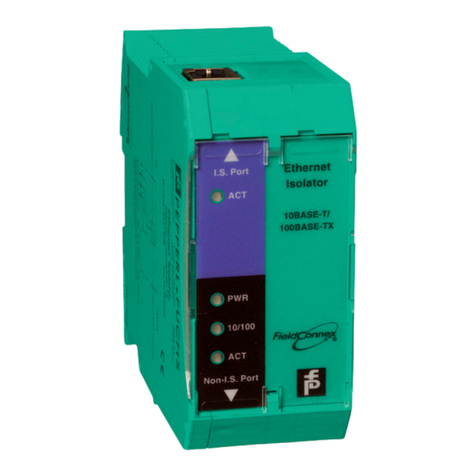
Pepperl+Fuchs
Pepperl+Fuchs EI-0D2-10Y-10B-LT manual
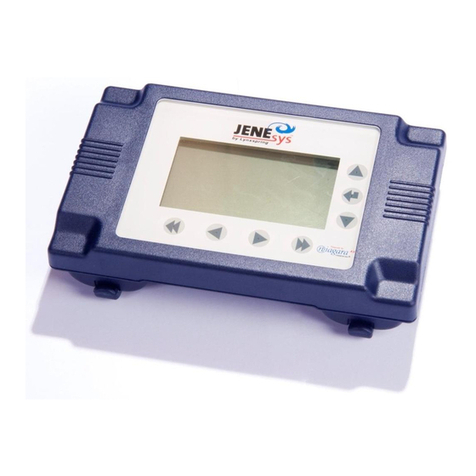
valent
valent VPR Series CONTROLS INSTRUCTION OPERATION & MAINTENANCE
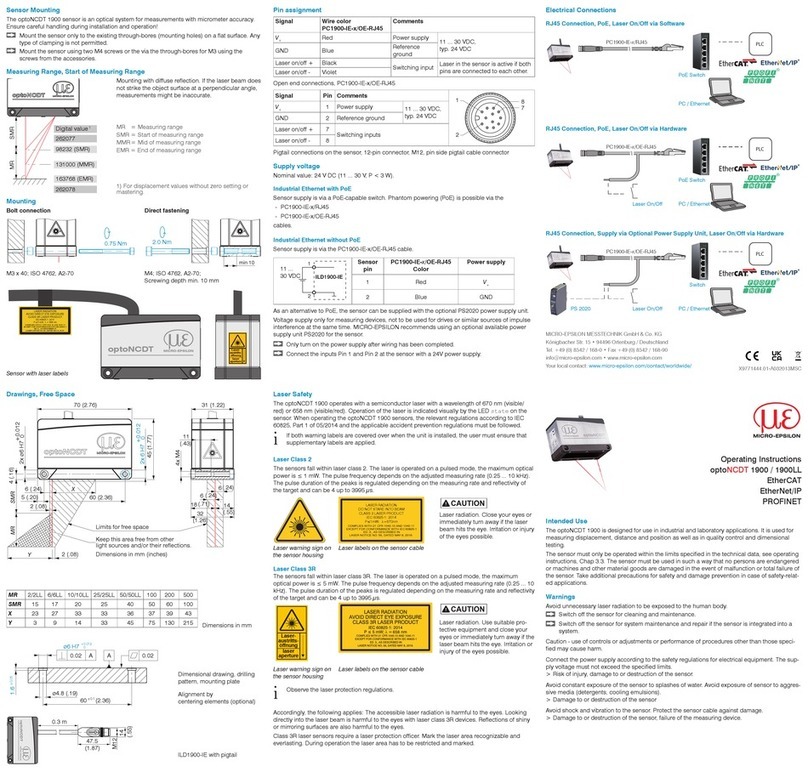
MICRO-EPSILON
MICRO-EPSILON optoNCDT 1900 Series operating instructions
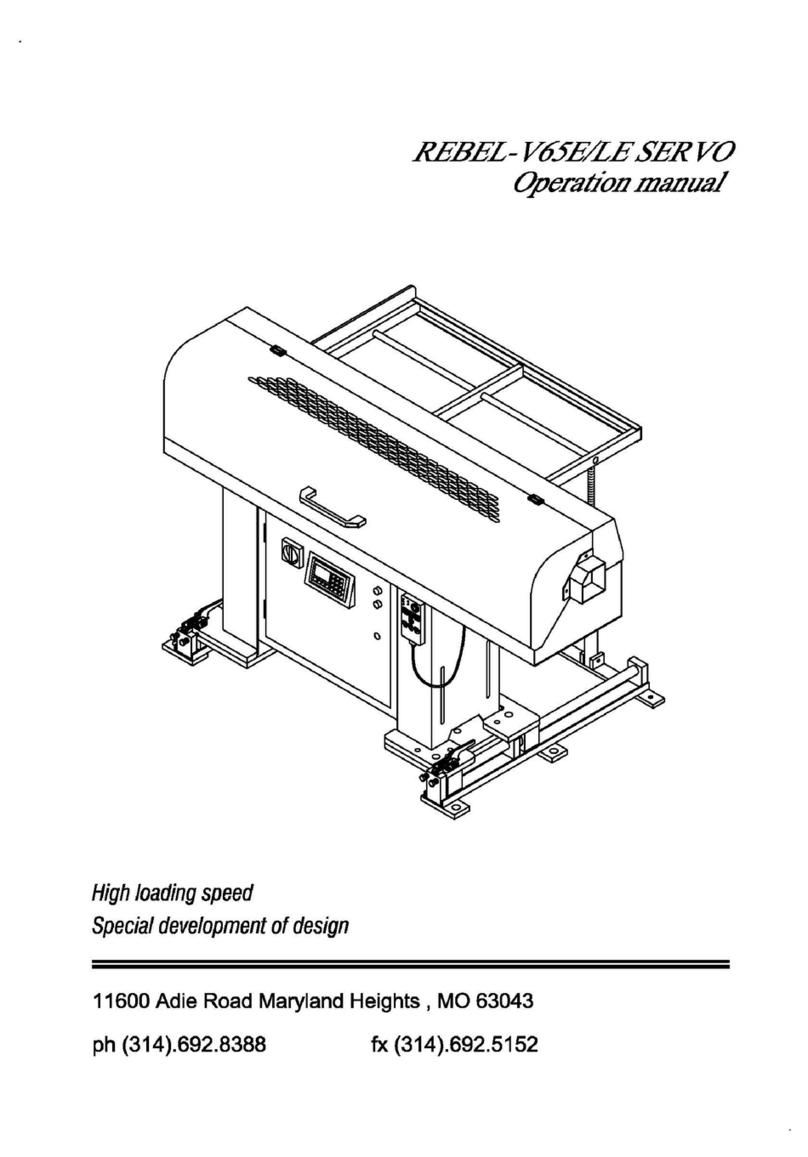
Edge
Edge REBEL-V65E SERVO Operation manual
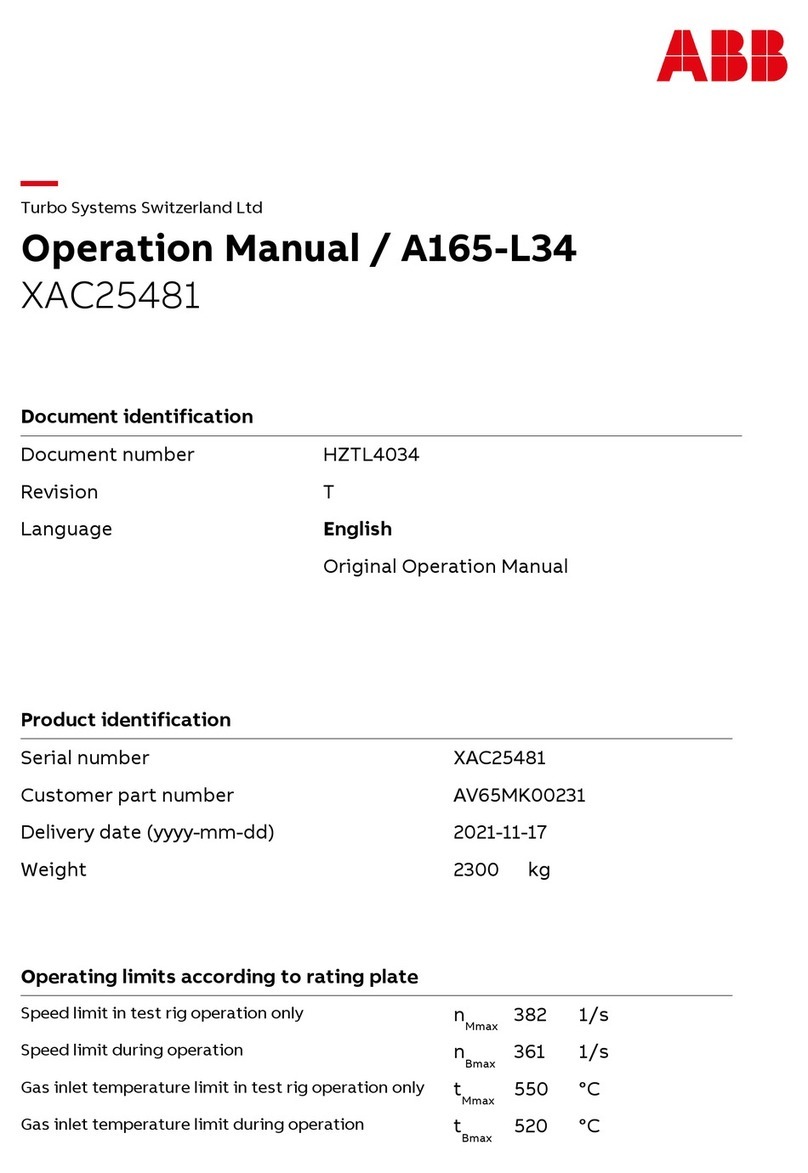
ABB
ABB XAC25481 Operation manual

Balluff
Balluff BTL5-P/I/L/M1-M-H/W(8)-S32/KA/K Series Condensed guide
